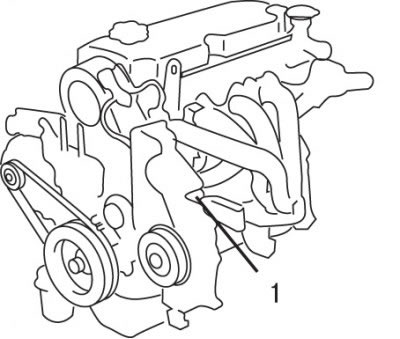Level check
1. The expansion tank, made of transparent plastic, is located in the engine compartment. The coolant level in this tank must be maintained between the two marks. The coolant level should be checked on a cold engine. The cooling system is of a closed type, so usually the loss of coolant should be very small. A noticeable drop in coolant level may indicate a coolant leak. In this case, have the cooling system checked and repaired by an authorized Mitsubishi dealer as soon as possible.

Pic. 2.8. The location of the expansion tank on vehicles with gasoline engines
2. If the coolant level in the expansion tank has dropped below the mark «LOW» («Short»), open the cap of the tank and add fluid (pic. 2.8).
3. If there is no coolant in the expansion tank, also remove the radiator cap and add coolant to it to the level of the filler neck.
Attention! Do not unscrew the cap of the expansion tank or radiator when the engine is hot. The cooling system is pressurized and when the plug is removed, hot fluid may splash out of the expansion tank, causing severe burns.
Antifreeze
The coolant contains ethylene glycol with an anti-corrosion additive. The cylinder head and water pump body are made of aluminum alloy, and the coolant must be replaced periodically to prevent corrosion. Use only genuine Mitsubishi Genuine Coolant or equivalent. The fluid has excellent anti-corrosion properties, protects against corrosion and rust formation of all metals, including aluminum, and helps prevent the formation of deposits in the engine radiator, heater, cooling jacket of the cylinder head, cylinder block, etc. The coolant must contain anti-corrosion additives, so it cannot be replaced with plain water even in summer. The required concentration of antifreeze in the coolant depends on the expected air temperature.
Attention! For low temperature performance and corrosion prevention, maintain an antifreeze concentration of 30-60%. Concentrations above 60% will reduce the effectiveness of the antifreeze (increase in the temperature of the beginning of crystallization) and impairs its cooling capacity, which adversely affects the operation of the engine.
Coolant replacement
1. Drain the coolant from the radiator by first removing the radiator drain plug and then the radiator cap.

Pic. 2.9. Plug location (1) engine drain hole
2. Unscrew the drain plug of the cylinder block and drain the coolant from the engine (pic. 2.9).
3. Remove the expansion tank and drain the coolant from it.
4. After draining the coolant, fill the radiator with clean water to flush the cooling system.
5. Apply 3M Nut Locking Part No. 4171 to the cylinder block drain plug threads and torque to 39 Nm.
6. Tightly tighten the radiator drain plug.
7. Install the expansion tank.

Pic. 2.10. Air bleed bolt location: 1 - thermostat housing; 2 – a bolt for removal of air; 3 - gasket
8. Turn out a bolt for removal of air from the cooling system and replace a sealing lining (pic. 2.10).
9. Pour coolant into the radiator until coolant overflows from the cooling system bleed bolt hole, then tighten the bolt.
10. Slowly pour coolant into the radiator until it is full (to the lower edge of the filler neck), fill the expansion tank to the mark «FULL».
11. Screw on the radiator cap tightly.
12. Start the engine and warm it up until the thermostat opens. To check, touch the radiator hose with your hand - when the thermostat is open, it should be warm.
13. After opening the thermostat, press the accelerator pedal several times, and then stop the engine.
14. Let the engine cool down and add coolant to the expansion tank up to the mark «FULL».
Flushing the cooling system
The coolant must be changed periodically, and the cooling system must be flushed, as rust and dirt form in the channels of the system.
The radiator must be flushed regardless of the engine.
Flushing the radiator
1. Disconnect the hoses from the radiator.
2. Insert the hose into the inlet of the upper tank of the radiator, turn on the water and flush the radiator until clean water appears from the lower tank of the radiator.
3. If you cannot flush the radiator with clean water, use a detergent.
Engine flush
1. Remove the thermostat and temporarily install its cover.
2. Disconnect the hoses from the radiator, supply a stream of clean water through the hose to the engine block through the upper radiator hose and flush it until clean water appears from the lower hose leading to the radiator.
3. Install the thermostat and connect the cooling system hoses.
